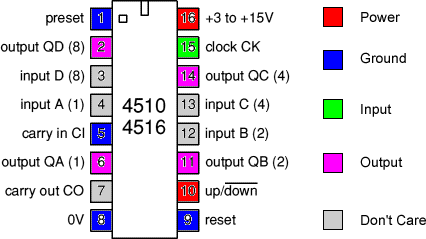Jun 3
May 25
We will run until ALL students have presented their ISPs
May 21
May 19
![]()
May 14
![]()
First Specialized IC:
The 4516 Up/Down (0-16) Counter
May 12
Fig L27-2
Table L27-4
RC Circuit Drain
The
NAND Gate Oscillator (NGO)
Work Period

May 8
At Rest & Active
Tablet Graphics:
NANDGate1, NANDGate2
May 6
Brief ISP Update
Digging deeper into the NAND Gate
Gate Emulation using NAND Gates
Lessons 19-21:
TP1, TP2, TP3, TP4
Similar Circuit
Troubleshooting, Analysis
RC Timing: `T=R*C`
May 4
Apr 30
Work Period for either:
Digital (Transistor-Based) Logic Gates
or your ISP
(your choice)
Fritzing Logic Gate: TransistorLogicGate.fzz
Apr 28
ISP Update
Transistor-Based AND Gate:TTL AND
Fritzing Rendering: TransistorANDGate.fzz
The other TTL Gates:
TTL OR, TTL NAND, NOR Animation
Fritzing Logic Gate: TransistorLogicGate.fzz
Apr 24
CBC Tournament: Semi-Finals
~~~~~
(Familiar) SET Logic:
Venn Diagrams
(ex: Greek, Latin, Russian Glyphs)
~~~~~
PB SWITCH Logic:
Unary (1-Input), Binary (PBNO 2-input)
~~~~~
Pull-Down and Pull-Up Resistor Configurations~~~~~
TRANSISTOR Logic (Gates):
NOT, AND, OR, EQU, NAND, NOR
Apr 22

Apr 20
Binary digIT packets:
bit (1), nybble (4), byte (8), word (16),
double word (32), quad word (64)
Character Encoding:
ASCII (1 byte), Unicode (2-4 bytes) (Wikipedia)
Apr 16
Reminder: ISP Discussion and Proposal
Binary Number System: Counting Applet
Binary(2), Octal(8), Decimal(10), Hexadecimal(16)
Apr 14
ISP Discussion and Proposal
Analog (Continuous)
vs
Digital (Discrete)
Review of the Decimal Number System
Apr 10
Automatic Night Light Work Period
Apr 8
Apr 2
Lesson 12: Your First Project:
The Automatic Night Light
Dry Fit ANL on PCB
Mar 31
Transistor Basics, Testing, and Switches
Electromagnetic Spectrum
Lesson 11. The Phototransistor
(aka Optoresistor)
Mar 27
Mar 25
Mar 4

Mar 2
(Ceramic Type Markings)
Push Buttons (PBNO, PBNC)
Figure L8-18, Figure L8-19
Capacitors & Push Buttons
Feb 26
Lesson 8: Capacitors
Feb 24
Review of Circuit Symbols
Feb 20
The Effect Resistors Have on a Circuit
Lesson 6. The Potentiometer
Feb 18
Calculators:
Resistor Sizes, Powers and Prefices
Lesson 5.
The Effect Resistors Have on a Circuit
Feb 12
Download & Edit: Sample.docx
Feb 10
Feb 6
Feb 4
Voltage Drop: Waterfall Model
Analysis of:
Lesson 3. Your First Circuit

Feb 2
Lesson 3: Your First Circuit
The LED Datasheet
Jan 22
Jan 20
ACES TA: Mariano Elia
[ACES Culture]























